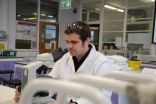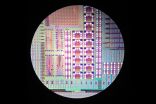INFORMATION:
Wisniewski and Jia also worked with Na Wang and Saijing Zheng, both doctoral candidates; Heng Xu, associate professor, Mary Beth Rosson, professor and associate dean, and John M. Carroll, distinguished professor, all of information sciences and technology.
The National Science Foundation supported this work.
Resilience, not abstinence, may help teens battle online risk
2015-04-23
(Press-News.org) Boosting teenagers' ability to cope with online risks, rather than trying to stop them from using the Internet, may be a more practical and effective strategy for keeping them safe, according to a team of researchers.
In a study, more resilient teens were less likely to suffer negative effects even if they were frequently online, said Haiyan Jia, post-doctoral scholar in information sciences and technology.
"Internet exposure does not necessarily lead to negative effects, which means it's okay to go online, but the key seems to be learning how to cope with the stress of the experience and knowing how to reduce the chances of being exposed to online risk," said Jia.
The researchers said that previous research tended to focus on limiting online use as a way to minimize risks of privacy violations and traumatic online experiences, such as becoming the victim of cyber-bullying and viewing unwanted sexual materials. However, with online technologies becoming more ubiquitous and a greater part of teens' social and educational lives, abstinence may actually be less reliable and more harmful.
"Let's assume that teens are going to deal with some online risk," said Pamela Wisniewski, a post-doctoral scholar in information sciences and technology. "If risk is going to be present, we want to make sure to minimize the negative outcomes and make sure the teens are equipped to handle these experiences."
Not allowing teens to use the Internet has its own risks, she added.
"As much as there are negatives associated with online use, there are also a lot of benefits to using online technologies," said Wisniewski. "Parents should be aware that restricting online use completely could hurt their children educationally and socially."
Both parents and technology companies may be able to help teens become more resilient, according to the researchers, who release their findings today (April 23) at the Computer Human Interaction conference in Seoul, South Korea.
Teens who are exposed to minimal risks can, over time, develop coping strategies and be more resilient as new, more risky situations arise.
"For example, let's say a teen girl is surfing online and one of her online friends asks for a nude photo," said Jia. "If a teen doesn't know how to deal with this, she might just succumb to the pressure and send the photo, and then suffer all kinds of stress and anxiety as a result, but if she builds up her resilience, she knows how to deal with the situation, she knows how to say no and prevent exposing herself to this risk."
The researchers suggest that technology companies that create cyber-security software could design software solutions that alert teens to risky behavior in order to avoid relying solely on parental monitoring software that restricts certain websites and social media sites.
"You don't want to parent strictly based on fear, you want to parent based on empowerment," said Wisniewski.
The researchers examined the responses of 75 teens, including 46 girls and 29 boys between 13 and 17 years old, to questions about how they used the Internet and what problems, if any, they encountered. To determine how excessive exposure to the Internet influenced negative outcomes, they analyzed teens who were at risk of Internet addiction. While there was a significant correlation between Internet addiction and negative effects, more resilient teens were less likely to be suffer negative consequences from extreme online exposure, according to the researchers.
ELSE PRESS RELEASES FROM THIS DATE:
Boiling down viscous flow
2015-04-23
CAMBRIDGE, Mass--Drizzling honey on toast can produce mesmerizing, meandering patterns, as the syrupy fluid ripples and coils in a sticky, golden thread. Dribbling paint on canvas can produce similarly serpentine loops and waves.
The patterns created by such viscous fluids can be reproduced experimentally in a setup known as a "fluid mechanical sewing machine," in which an overhead nozzle deposits a thick fluid onto a moving conveyor belt. Researchers have carried out such experiments in an effort to identify the physical factors that influence the patterns that form. ...
For lower-grade brain blood vessel malformations, surgery has 'excellent clinical outcomes'
2015-04-23
April 23, 2015 - Interventional treatments--especially surgery--provide good functional outcomes and a high cure rate for patients with lower-grade arteriovenous malformations (AVMs) of the brain, reports the May issue of Neurosurgery, official journal of the Congress of Neurological Surgeons. The journal is published by Wolters Kluwer.
The findings contrast with a recent trial reporting better outcomes without surgery or other interventions for AVMs. "On the basis of these data, in appropriately selected patients, we recommend treatment for low-grade brain AVMs," concludes ...
Taming polluters: Ratings have spillover effects, leading to reduced toxic emissions
2015-04-23
A new study by the University of Chicago Booth School of Business Assistant Professor Amanda Sharkey and University of Utah Assistant Professor Patricia Bromley found that environmental ratings have spillover effects on other companies' behavior. Rated firms reduce their toxic emissions even more when their peers are also rated. In addition, rated peers can even motivate some unrated companies to reduce their emissions.
The research is unusual in that the role of peers in conditioning how firms respond to ratings systems has received little examination.
The study, "Can ...
Crime scene discovery -- separating the DNA of identical twins
2015-04-23
SINCE its first use in the 1980s - a breakthrough dramatised in recent ITV series Code of a Killer - DNA profiling has been a vital tool for forensic investigators. Now researchers at the University of Huddersfield have solved one of its few limitations by successfully testing a technique for distinguishing between the DNA - or genetic fingerprint - of identical twins.
The probability of a DNA match between two unrelated individuals is about one in a billion. For two full siblings, the probability drops to one-in-10,000. But identical twins present exactly the same ...
Bold crickets have a shorter life
2015-04-23
This news release is available in German.
An individual's behaviour in risky situations is a distinct personality trait both in humans and animals that can have an immediate impact on longevity. Researchers from the Max Planck Institute for Ornithology in Seewiesen have now found differences in personality types for the first time in a population of free living field crickets. Risk-prone individuals showed a higher mortality as they stayed more often outside their burrow where they can be easily detected by predators, compared to risk averse individuals. Moreover, ...
A focus on flight
2015-04-23
Navigating through a cluttered environment at high speed is among the greatest challenges in biology - and it's one virtually all birds achieve with ease.
It's a feat David Williams hopes to understand.
A former post-doctoral fellow in the lab of Andrew Biewener, the Charles P. Lyman Professor of Biology, and a current post-doc at the University of Washington, Williams is the lead author of a study that shows birds use two highly stereotyped postures to avoid obstacles in flight. The study could open the door to new ways to program drones and other unmanned aerial ...
Pseudoparticles travel through photoactive material
2015-04-23
This news release is available in German.
Researchers of Karlsruhe Institute of Technology (KIT) have unveiled an important step in the conversion of light into storable energy: Together with scientists of the Fritz Haber Institute in Berlin and the Aalto University in Helsinki/Finland, they studied the formation of so-called polarons in zinc oxide. The pseudoparticles travel through the photoactive material until they are converted into electrical or chemical energy at an interface. Their findings that are of relevance to photovoltaics among others are now published ...
Ultra-sensitive sensor detects individual electrons
2015-04-23
A Spanish-led team of European researchers at the University of Cambridge has created an electronic device so accurate that it can detect the charge of a single electron in less than one microsecond. It has been dubbed the 'gate sensor' and could be applied in quantum computers of the future to read information stored in the charge or spin of a single electron.
In the same Cambridge laboratory in the United Kingdom where the British physicist J.J. Thomson discovered the electron in 1897, European scientists have just developed a new ultra-sensitive electrical-charge sensor ...
How experience may lead to misperception
2015-04-23
How long is the way from the city hall to the train station? When we estimate distances, something curious happens: short distances seem longer, and long distances shorter than they really are. Similar biases occur during judgments of volume, brightness or time. Psychologists call this phenomenon Vierordt's law. Its independence of the involved sensory systems suggests that our brain possesses universal principles for the assessment of physical quantities. However, where do the characteristic estimation biases stem from? In collaboration with colleagues from Zurich, neuroscientists ...
When is a child too sick for daycare? Study explores parents' decision-making
2015-04-23
It's a common dilemma faced by many working parents: your child has a cough or a cold, do you send them to nursery?
Researchers from the University of Bristol have, for the first time, investigated the process of decision-making that parents go through when faced with this situation. The research, published in The Journal of Public Health, reports that parents viewed coughs and colds as less serious and not as contagious as sickness and diarrhoea symptoms.
This resulted in many parents sending their child to daycare with a respiratory tract infection (RTI), which can ...




